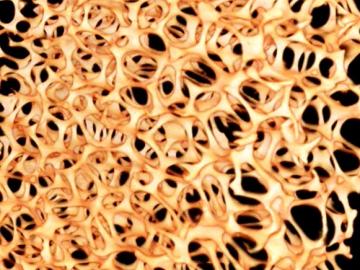Filter News
Area of Research
- (-) Building Technologies (3)
- (-) Computer Science (9)
- Advanced Manufacturing (8)
- Biological Systems (1)
- Biology and Environment (56)
- Biology and Soft Matter (1)
- Clean Energy (109)
- Climate and Environmental Systems (2)
- Computational Biology (1)
- Computational Engineering (1)
- Electricity and Smart Grid (1)
- Functional Materials for Energy (2)
- Fusion and Fission (15)
- Fusion Energy (6)
- Isotopes (3)
- Materials (98)
- Materials for Computing (6)
- National Security (30)
- Neutron Science (37)
- Nuclear Science and Technology (11)
- Quantum information Science (3)
- Renewable Energy (1)
- Supercomputing (70)
- Transportation Systems (1)
Media Contacts

Oak Ridge National Laboratory researchers demonstrated that microchannel heat exchangers in heating, ventilation and air conditioning units can keep refrigerants evenly and continually distributed by inserting a device called a piezoelectric-driven

Oak Ridge National Laboratory researchers demonstrated that an electrochemical sensor paired with a transmitter not only detects propane leaks within seconds, but it can also send a signal to alert emergency services.

A force within the supercomputing community, Jack Dongarra developed software packages that became standard in the industry, allowing high-performance computers to become increasingly more powerful in recent decades.

ORNL computer scientist Catherine Schuman returned to her alma mater, Harriman High School, to lead Hour of Code activities and talk to students about her job as a researcher.

Researchers at Oak Ridge National Laboratory demonstrated that metal foam enhances the evaporation process in thermal conversion systems and enables the development of compact HVAC&R units.

Three researchers at Oak Ridge National Laboratory will lead or participate in collaborative research projects aimed at harnessing the power of quantum mechanics to advance a range of technologies including computing, fiber optics and network

In collaboration with the Department of Veterans Affairs, a team at Oak Ridge National Laboratory has expanded a VA-developed predictive computing model to identify veterans at risk of suicide and sped it up to run 300 times faster, a gain that could profoundly affect the VA’s ability to reach susceptible veterans quickly.

Oak Ridge National Laboratory is training next-generation cameras called dynamic vision sensors, or DVS, to interpret live information—a capability that has applications in robotics and could improve autonomous vehicle sensing.

A detailed study by Oak Ridge National Laboratory estimated how much more—or less—energy United States residents might consume by 2050 relative to predicted shifts in seasonal weather patterns

Researchers at Oak Ridge National Laboratory are taking inspiration from neural networks to create computers that mimic the human brain—a quickly growing field known as neuromorphic computing.




